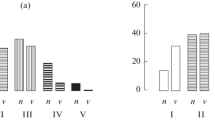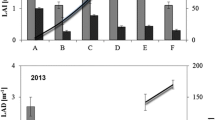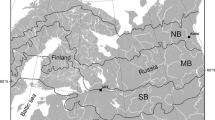Abstract
The distribution of the above-ground and below-ground biomass of Scots pine in southern Finland were investigated in trees of different ages (18–212 years) from two types of growth site. Secondly, some structural regularities were tested for their independence of age and growth site. Trees were sampled from dominant trees which could be expected to have a comparable position in stands of all ages. All stands were on sorted sediments. The biomass of the sample trees (18 trees) was divided into needles, branch sapwood and heartwood, stem sapwood and heartwood, stem bark, stump, large roots (diameter >20 cm), coarse roots (five classes) and fine roots. The amount of sapwood and heartwood was also estimated from the below-ground compartments. Trees on both types of growth site followed the same pattern of development of the relative shares of biomass compartments, although the growth rates were faster on the more fertile site. The relative amount of sapwood peaked after canopy closure, coinciding with the start of considerable heartwood accumulation. The relative amount of needles and fine roots decreased with age. The same was true of branches but to a lesser degree. The relative share of the below-ground section was independent of tree age. Foliage biomass and sapwood cross-sectional area were linearly correlated, but there were differences between the growth sites. Needle biomass was linearly correlated with crown surface area. The fine root to foliage biomass ratio showed an increasing trend with tree age.
Similar content being viewed by others
References
Albrektson A (1980) Relations between tree biomass fractions and conventional silvicultural measurements. In: Persson T (ed) Structure and function of northern coniferous forest — an ecosystem study. Ecol Bull (Stockholm) 32: 315–327
Albrektson A (1984) Sapwood basal area and needle mass of Scots pine (Pinus sylvestris L.) trees in Central Sweden. Forestry 57: 35–43
Bossel H (1986) Dynamics of forest dieback: systems analysis and simulation. Ecol Modelling 34: 259–288
Brix H, Mitchell AK (1983) Thinning and nitrogen fertilization effects on sapwood develpement and relationships of foliage quantatity to sapwood area and basal area in Douglas-fir. Can J For Res 13: 384–389
Brouwer R (1962) Distribution of dry matter in the plant. Neth J Agr Sci 10: 361–376
Burger H (1929) Holz, Blattmenge und Zuwachs. 1. Mitteilung: Die Weimouthsföhre. Eidg Anst Forstl Versuchswes Mitt 15: 243–292
Burger H (1941) Holz, Blattmenge und Zuwachs. 5. Mitteilung: Fichten, und Föhren verschiedener Herkunft auf verschiedenen Kulturorten. Eidg Anst Forstl Versuchswes Mitt 22: 10–62
Cajander AK (1949) Forest types and their significance. Acta For Fenn 56
Cannell MGR (1982). World forest biomass and primary production data. Academic Press, London
Davidson RL (1969). Effect of root/leaf temperature differentials on root/shoot ratios in some pasture grasses and clover. Ann Bot 33: 561–569
Ford-Robertson FC (1971) (ed) Terminology of forest science, technology, practice and products. Science Publishing House, Peking, China
Forrest WG, Ovington JD (1970) Organic matter changes in an age series ofPinus radiata plantations. J Appl Ecol 7: 177–186
Grier CC, Lee KM (1984) Effect of urea fertilization on allometric relations in young Douglas-fir trees. Can J For Res 14: 900–904
Ingestad T, Aronsson A, Ågren GI (1981) Nutrient flux density model of mineral nutrition in conifer ecosystems. Stud For Suec 160: 61–71
Ingestad T, Ågren GI (1991) The influence of plant nutrition on biomass allocation. Ecol Appl 1: 168–174
Kira T, Shidei T (1967) Primary production and turnover of organic matter in different forest ecosystems of the Western Pacific. Jpn J Ecol 17: 205–229
Mäkelä A (1988) Perfomance analysis of a process-based stand growth model using Monte Carlo techniques. Scand J For Res 3: 315–331
Mäkelä A, Albrektson A (1992) An analysis of the relationship between foliage biomass and crown surface area inPinus sylvestris in Sweden. Scand J For Res 7: 297–307
Mäkelä A, Sievänen R (1992) Height growth strategies in open-grown trees. J Theor Biol 159: 443–467
Marklund LG (1988) Biomass functions for pine, spruce and birch in Sweden (in Swedish) Sveriges Lantbruksuniversitet. Intstitutionen för skogstaxering. Rapport 45
Marks PL (1974) The role of pin cherry (Prunus pensylvanica L.) in the maintenance of stability in northern hardwood ecosystems. Ecol Monogr 44: 73–88
Mohler CL, Marks PL, Sprugel DG (1978) Stand structure and allometry of trees during self-thinning of pure stands. J Ecol 66: 599–614
Nikinmaa E, Hari P (1990) A simplified partitioning model for Scots pine to address the effects of altered needle longevity and nutrient uptake on stand development. In: Dixon RK, Meldahl RS, Ruark GA, Warren WG (eds) Process modeling of forest growth responses to environmental stress. Timber Press, Portland, Oregon, pp 263–270
Nikolov NT, Fox DG (1994) A coupled carbon-water-energy-vegetation model to assess responses of temperate forest ecosystems to changes in climate and atmospheric CO2. Part I. Model concept. Environ Pollut 83: 251–262
Persson H (1980) Death and replacement of fine roots in a mature Scots pine stand. In: Persson T (ed) Structure and function of northern coniferous forests — an ecosystem study. Ecol Bull (Stockholm) 32: 251–261
Santantonio D (1989) Dry-matter partitioning and fine-root production in forests — new approaches to a difficult problem. In: Pereira JS, Landsberg JJ (eds) Biomass production by fast-growing trees. NATO ASI Series, vol 41. Kluwer, Dordrecht, The Netherlands, pp 57–72
Shelburne VB, Hedden RL, Allen RM (1993) The effects of site, stand density and sapwood permeability on the relationship between leaf area and sapwood area in loblolly pine (Pinus taeda L.). For Ecol Manage 58: 193–209
Shinozaki K, Yoda K, Hozumi K, Kira T (1964) A quantitative analysis of plant form — the pipe model theory. I. Basic analyses. Jpn J Ecol 14: 97–105
Sievänen R (1993) A process-based model for the dimensional growth of even-aged stands. Scand J For Res 8: 28–48
Sprugel DC (1974) Vegetation dynamics of waveregenerated high-altitude fir forest. Ph.D thesis, Yale University, New Haven, Conn., USA
Sprugel DG (1984) Density, biomass, productivity, and nutrient-cycling changes during stand development in wave regenerated Balsam fir forests. Ecol Monogr 54: 165–186
Valentine HT (1988) A carbon-balance model of stand growth: a derivation employing pipe-model theory and the self-thinning rule. Ann Bot 62: 389–396
Waring RH, Schroeder PE, Oren R (1982) Application of the pipe model theory to predict canopy leaf area. Can J For Res 12: 556–560
West PW (1993) Model of above-ground assimilate partitioning and growth of individual trees in even-aged forest monoculture. J Theor Biol 161: 369–394
Zeide B, Pfeifer P (1991) A method for estimation of fractal dimension of tree crowns. For Sci 37: 1253–1265
Author information
Authors and Affiliations
Rights and permissions
About this article
Cite this article
Vanninen, P., Ylitalo, H., Sievänen, R. et al. Effects of age and site quality on the distribution of biomass in Scots pine (Pinus sylvestris L.). Trees 10, 231–238 (1996). https://doi.org/10.1007/BF02185674
Received:
Accepted:
Issue Date:
DOI: https://doi.org/10.1007/BF02185674




